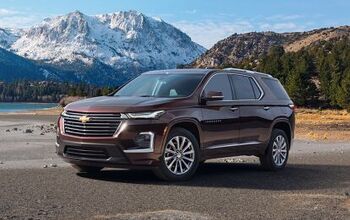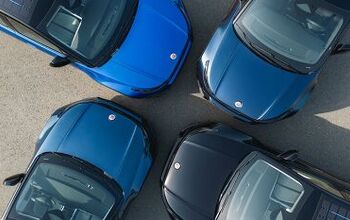QOTD: Overlooked, but Not Forgotten?

Ronnie’s piece yesterday on the Bandit car that couldn’t be got me thinking. But not about famous cars of Hollywood cinema, mind you. Not about an impeccably dressed Steve McQueen tossing and bouncing a Highland Green Mustang over the streets of Jefferson Airplane-era San Fran, nor about a lawless-but-amiable Burt Reynolds running defence for a rig full of suds in his ’77 Trans Am. American Graffiti? Nope. Christine? Forget about that turd. Gone In 60 Seconds, version one or deux? Nada. Not even the schlockfest The Car registered in this tired brain.
My thoughts turned, instead, to movie cars that do not get movie-loving car nuts worked up into a froth. Film stars in their own right that, sadly, don’t get enough credit. You’ve probably got a few of these overlooked, four-wheeled matinee idols rolling around in your mind right now.
The choices are endless. However, as the better part of my childhood was spent watching old shows and movies on an 8-channel Sony TV (sports involves risk, you see), yours truly’s most indelible automotive memories come from the decade of disco, polyester, and brougham barges.
So it’s no wonder that I have a fondness for the 1972 Ford Custom 500 piloted by one Inspector Harry Callahan near the finale of Magnum Force, in which a suddenly straight-laced Callahan battles the dastardly Lieutenant Neil Briggs while trying to pilot two tons of sliding steel around the mean streets of San Francisco. As a youngster, my fascination with that movie didn’t end with the .357 Colt Pythons popping out of every holster in sight. “A car can take that much punishment and abuse?” little Steph wondered, mouth agape.
But even that car is too cool. A more famous movie vehicle, one which appears in nearly every frame of the film, is a vehicle chosen from the very beginning for its lack of appeal. Its focus was on affordability and fuel economy, not its ability to pull off photogenic burnouts and quick quarter miles. It is the 1970 Plymouth Valiant in the film Duel. That red Valiant sedan is as much a character as its emasculated driver, Dennis Weaver, the 1955 Peterbilt pursuing it through the SoCal desert, and its unseen (or barely seen) driver. The car was chosen to serve as the tepid, mild-mannered vehicular embodiment of its owner.
A recent documentary I watched on the making of Steven Spielberg’s breakout 1971 film contained numerous juicy tidbits. Filmed in just 12 days for an ABC TV audience, Duel is a brilliant, minimalist tale of roadbound terror, subtly soaked in the social issues of its time. It’s also a master class in film editing.
Depending on which Duel you encounter, it’s either 74 or 89 minutes long. After garnering much critical acclaim on TV, footage was added to pad the movie to feature film length. Universal released it overseas the following year. Two Valiants, both red (obviously), were used for the initial filming, one a 1970 model with a 318 V8, the other a ’71 model with a 225 cid Slant Six. Tires skinnier than a late-60s British clothing model came standard. For the theatrical release, new footage was needed, so a third Valiant appeared in the unseen credits: a ’72 Slant Six model.
Apparently, if you watch the movie beginning to end, you’ll see no other red car. That’s no accident. Spielberg wanted the loafer-wearing Weaver’s car to stand out.
As the sedate conveyance of a hen-pecked and conflicted salesman who finds himself locked in a battle to the death with an unseen stranger and his seemingly demonic diesel tanker, the trio of Valiants did their job. Like men, they’re fallible and have Achilles heels (like poor roadholding, languid acceleration, and overtaxed radiator hoses) but, like most cars of the 1970s, they’re also resilient. Just as the driver can overcome mounting hysteria and reclaim his long-buried primal nature, the Valiant can get underway after overheating and suffering a roughly 30 mph front-end impact.
Of all the movie cars that don’t get enough credit for making the film memorable, this one (well, these three) stands at the top. What’s your choice?
[Images: Ford, The Malpaso Company/Warner Brothers via IMCDB.org, Universal Pictures via IMCDB.org]

More by Steph Willems
Latest Car Reviews
Read moreLatest Product Reviews
Read moreRecent Comments
- Tassos So Tim believes that if you steal an item (here, CONDOMINIUM ASSOCIATION ELECTRICITY) priced less than a certain amount, you should be allowed to do so with no consequences. He is lucky some litigious Condo Board member did not SUE HIM. I bet they wanted to, but knowing he is destitute, their lawyer discouraged them from doing so.
- Bd2 Ultimately, it comes down to price/whether it makes financial sense for buyers (right now, BEVs just aren't there, even with the tax credit). HEVs are finally seeing their place in the sun, decades after being a niche market; this is due to premium for HEVs having narrowed significantly with pure ICE, whereby buyers can recoup that after 2-3 years of ownership.
- MaintenanceCosts I've experienced three cars that were the first year of the model. The two I bought (first-off-the-boat 2004 TSX and midyear 2006 Civic) were both Hondas and were both flawless. The other one was my ex-stepmother's 1990 Land Rover Discovery. It was one of the very first Euro-spec models, a two-door with an asthmatic carbureted 3.5L V8 and a five-speed manual. Every part of the car broke at some point, including things like hatch hinges that really shouldn't break. It turned her off Land Rover forever, and her cars since have all been Subarus.
- MaintenanceCosts When I was living with my Bolt in a rental condo and charging from 120V in the garage, as soon as the association figured out what was happening, they asked me to pay $30 a month to cover the cost. That's pretty close to what I was using so I had no issue with it.
- SCE to AUX I've had mixed results with first-year cars:71 Pinto - good. 85 LeBron GTS - good. 96 Grand Voyager - good. 02 Passat B5.5 - bad. 05 Odyssey - bad. I also had a last-year car that was terrible (80 Bobcat), but most cars were crap then, anyway.





































Comments
Join the conversation
How about Burt Reynolds big ole brown Ford in Gator - or the god awful cartoony corvette in Corvette Summer
The '66 Impala from Dirty Mary, Crazy Larry The Stutz IV-Porte driven by Michael Keaton from Night Shift The Mustang Sportsroof from Mr. Billion The very brief cameo appearance of the '77 Cadillac Seville that was fashion coordinated to the Madeline Kahn character's pantsuit is something that I'll never forget.